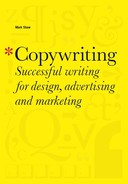Case Study: Amnesty International
Nick Holmes is the creative director and copywriter at graphic design agency Different Kettle in Bristol, UK. The agency is run by creatives and is focused on delivering great creative solutions by getting the brief right from the very start. They have won many awards for their work, and have generated excellent responses through their direct-marketing activity. So how did he create this hard-hitting insert for Amnesty?

create a generic fund-raising press insert
We do a lot with Amnesty, and have a long history with them. They decided that they would run a creative pitch for their acquisition inserts, which were to appear mainly in the mainstream quality press. The brief was as simple as “we need a new insert that is not issue-specific and will not date.” This was a very open brief – we could write as much or as little copy as we felt we needed to.
The customer profile defined the audience as people who are well read and interested in current affairs. We were up against our previous work, and we decided to do something that was generic and wasn’t time-sensitive. We presented four concepts and the client developed two of them. One was
a “hefty” read, consisting of an eight-page booklet debating the use of torture and whether it can ever be justified. The other concepts we used were about changing the news by joining Amnesty and making a difference.
People always feel the need to describe the Amnesty tone of voice. The broad essence is about humanity, and about a movement of ordinary people standing up against injustice around the world. We could qualify the tone of voice as: “simplify, humanize, and make it easy to participate.” We don’t put tone of voice on our briefs, because if the brief is clear the tone of voice will inevitably follow. The tone of voice has to be true to the specific concept or idea.
Corporate guidelines can be inward-looking.
As far as I am concerned, I talk differently to different people – to my children, to my colleagues, and to my friends – but I am still a consistent person. The best approach is to aim to avoid corporate speak at all times.
Direct marketing is cruel because there is an immediate measure of success. We shelve this fear and instead of worrying about what the response will be we go back to the original creative idea and see how true we are being to it, looking for ways to enhance it and eliminating anything that detracts from it. We just think about this, not how many people are reading it, or the rules of direct marketing. Like any rules, it’s good to know them, but do be prepared to break them. Some rules say that with mail packs you should “always make the accompanying letters long,” but sometimes we don’t have a letter at all.
I think everything should be edited as tightly as possible in every case. It might still be a four-page letter, but it could have started as an eight-page letter. I’m a great one for rewriting and cutting.
The Approach:
developing copy and design in unison
The gold dust is in the raw material. It’s critical to have good material to work with, because although you’re being creative you are not making anything up. You can’t polish a turd. The background research and reading around the subject creates lots of great material. Sometimes if you read a fact there’s the creative concept staring you in the face. It’ll need crafting and shaping, but you know you’ve got the essence.
We have an instinctive feel about what will work, but we sometimes disagree amongst ourselves. You can’t always predict how well a piece of marketing will perform, but if we’re not excited by it ourselves then we usually start again.
We always work as a team, with an art director and writer working in close partnership, and share creative ideas. We develop the core design and copy concept, presenting this to the client before writing body copy. The copy at this stage consists of a main headline and our top-line thinking. In this case, our mock-up was almost exactly the same as the final version, and once they went with it the copywriting was simply about adding flesh to the bones.
It wasn’t all plain sailing: the art director had to be talked around to our point of view on designing around the copy’s strength before we could present it to the client, as he felt there was not enough creativity in the design. Amnesty’s new guidelines included the use of fluorescent colors, which is where the pink lettering came from.
The concept’s strength was its simplicity. We know that no one wants to read inserts, so we played on this with the “throw this away” line. But then we very quickly had to tell the reader what this is all about – as soon as they open it up.
The Result:
generating good responses
The insert has done really well. The client seldom expects the inserts to pay for themselves, but on the first outing this insert appears to be bringing in more than the cost of the whole campaign (donors pay by direct debit and it takes a while to properly assess the full response).
It is interesting to consider the criteria for what is “working” and “not working.” We did an arms-control pack raising awareness of arms sales. It won lots and lots of awards, but it wasn’t one of the client’s hardest-working appeals. It is more difficult to raise money in some subjects than others, and it’s not always due to the creative treatments.

